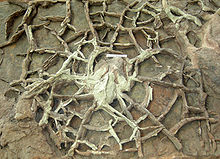Desiccationis the state of extreme dryness, or the process of extremedrying.Adesiccantis ahygroscopic(attracts and holds water) substance that induces or sustains such a state in its local vicinity in a moderately sealed container. The word desiccation comes fromLatinde-'thoroughly' andsiccare'to dry'.


Industry
editDesiccation is widely employed in the oil and gas industry. These materials are obtained in a hydrated state, but the water content leads to corrosion or is incompatible with downstream processing. Removal of water is achieved bycryogeniccondensation, absorption into glycols, and absorption onto desiccants such assilica gel.[1]
Laboratory
editAdesiccatoris a heavyglassorplasticcontainer, now somewhat antiquated, used in practicalchemistryfor drying or keeping small amounts of materials very dry. The material is placed on a shelf, and a drying agent ordesiccant,such as drysilica gelor anhydroussodium hydroxide,is placed below the shelf.
Often some sort ofhumidityindicator is included in the desiccator to show, by color changes, the level of humidity. These indicators are in the form of indicator plugs or indicator cards. The active chemical iscobalt chloride(CoCl2).Anhydrouscobalt chloride is blue. When it bonds with two water molecules, (CoCl2•2H2O), it turns purple. Further hydration results in the pink hexaaquacobalt(II) chloride complex [Co(H2O)6]2+.
Biology and ecology
editInbiologyandecology,desiccation refers to the drying out of a living organism, such as when aquatic animals are taken out of water,slugsare exposed to salt, or when plants are exposed to sunlight or drought. Ecologists frequently study and assess various organisms' susceptibility to desiccation. For example, in one study the investigators found thatCaenorhabditis elegansdaueris a true anhydrobiote that can withstand extreme desiccation and that the basis of this ability is founded in the metabolism oftrehalose.[2]
DNA damage and repair
editSeveral bacterial species have been shown to accumulateDNAdamage upon desiccation.Deinococcus radioduransis extremely resistant toionizing radiation.The functions necessary to survive ionizing radiation are also necessary to survive prolonged desiccation.[3]Radiation resistance is considered to be an incidental consequence of the organism's evolutionary adaptation to dehydration, a common physiological stress in nature.[3]The chromosomal DNA from desiccatedD. radioduransrevealed increased DNA double-strand breaks.[4]DNA double-strand breaks are repaired principally by a RecA-dependent recombination process that requires the presence of two genome copies.[4]By this processD. radioduranscan survive thousands of double-strand breaks per cell.[4]
Mycobacterium smegmatismutantstrains that are deficient in the ability to repair double-strand breaks by the non-homologous end joining (NHEJ) pathway are more sensitive to prolonged desiccation during stationary phase thanwild-typestrains.[5]NHEJ appears to be the preferred pathway for repairing double-strand breaks caused by desiccation during the stationary phase. NHEJ can repair double-strand breaks even when only one chromosome is present in a cell.
Upon exposure to extreme dryness,Bacillus subtilisendosporesacquire DNA-double strand breaks and DNA-protein crosslinks.[6]
Broadcasting
editInbroadcast engineering,a desiccator may be used topressurizethefeedlineof a high-power transmitter. Because it carries a large amount of energy from thetransmitterto theantenna,the feedline must have lowdielectriclosses. Because it must also be lightweight so as not to overload theradio tower,air is often used as the dielectric. Sincemoisturecancondensein these lines, desiccated air ornitrogengasis pumped in. Thispressurealso keepswateror otherdampnessfrom coming into the line at any point along its length.
See also
editReferences
edit- ^Reinicke, Kurt M.; Hueni, Greg; Liermann, Norbert; Oppelt, Joachim; Reichetseder, Peter; Unverhaun, Wolfram (2014). "Oil and Gas, 8. Field Processing".Ullmann's Encyclopedia of Industrial Chemistry.Wiley-VCH. pp. 1–13.doi:10.1002/14356007.r18_r07.ISBN9783527306732.
- ^Erkut, Cihan (9 August 2011)."Trehalose Renders the Dauer Larva of Caenorhabditis elegans Resistant to Extreme Desiccation".Current Biology.21(15): 1331–1336.doi:10.1016/j.cub.2011.06.064.PMID21782434.S2CID18145344.
- ^abMattimore V, Battista JR (1996)."Radioresistance of Deinococcus radiodurans: functions necessary to survive ionizing radiation are also necessary to survive prolonged desiccation".J. Bacteriol.178(3): 633–7.doi:10.1128/jb.178.3.633-637.1996.PMC177705.PMID8550493.
- ^abcZahradka K, Slade D, Bailone A, Sommer S, Averbeck D, Petranovic M, Lindner AB, Radman M (2006). "Reassembly of shattered chromosomes in Deinococcus radiodurans".Nature.443(7111): 569–73.Bibcode:2006Natur.443..569Z.doi:10.1038/nature05160.PMID17006450.S2CID4412830.
- ^Pitcher RS, Green AJ, Brzostek A, Korycka-Machala M, Dziadek J, Doherty AJ (2007)."NHEJ protects mycobacteria in stationary phase against the harmful effects of desiccation"(PDF).DNA Repair (Amst.).6(9): 1271–6.doi:10.1016/j.dnarep.2007.02.009.PMID17360246.
- ^Dose K, Gill M (1995). "DNA stability and survival of Bacillus subtilis spores in extreme dryness".Orig Life Evol Biosph.25(1–3): 277–93.Bibcode:1995OLEB...25..277D.doi:10.1007/BF01581591.PMID7708386.S2CID19698042.